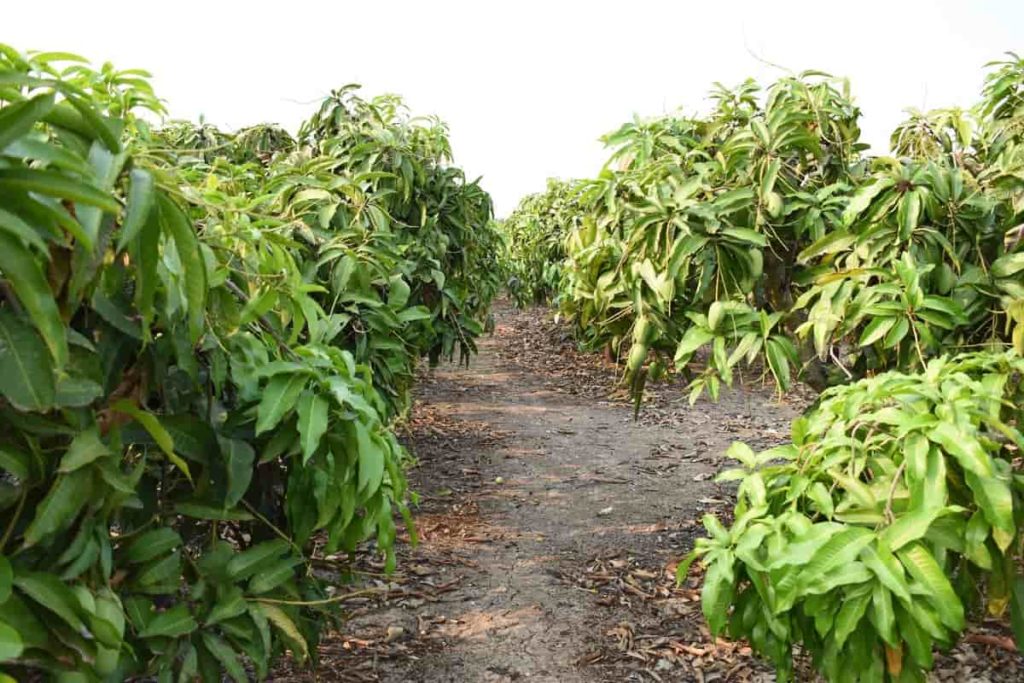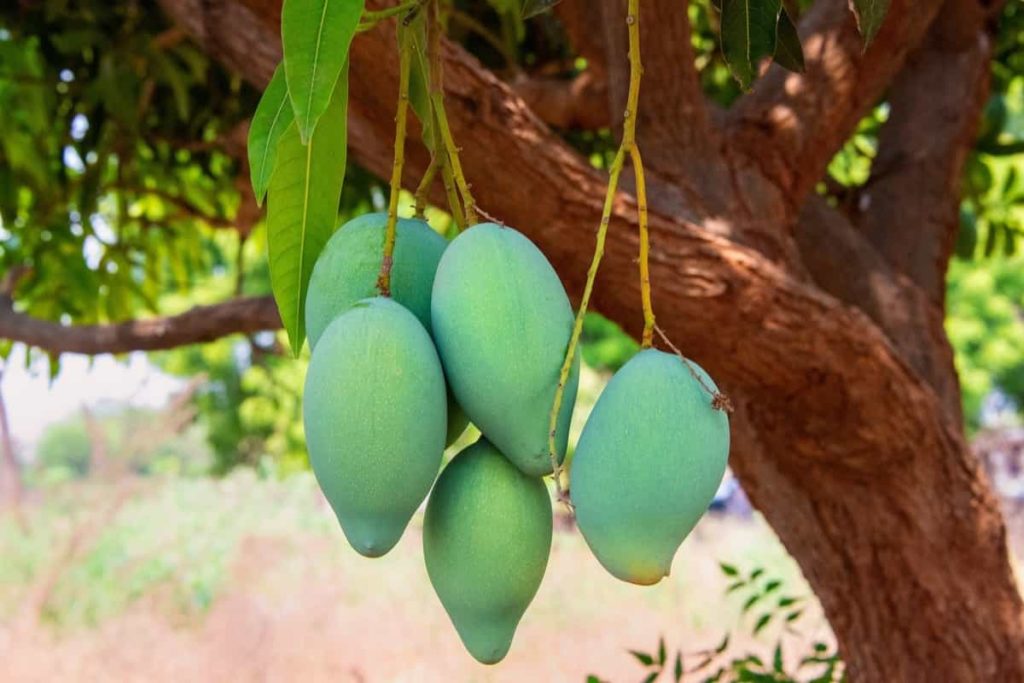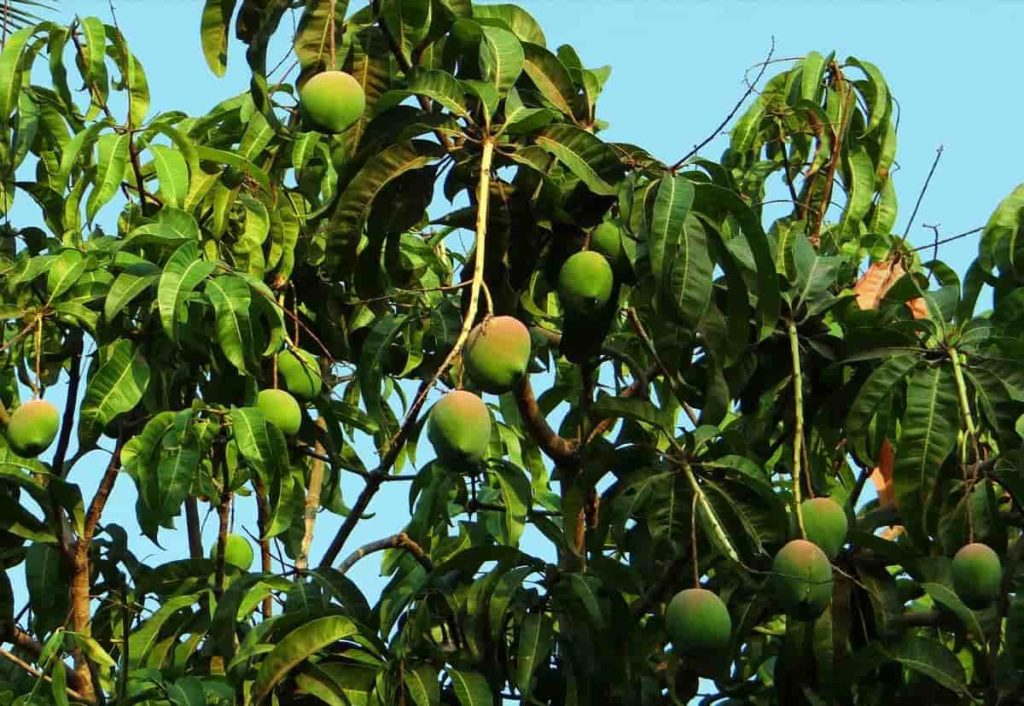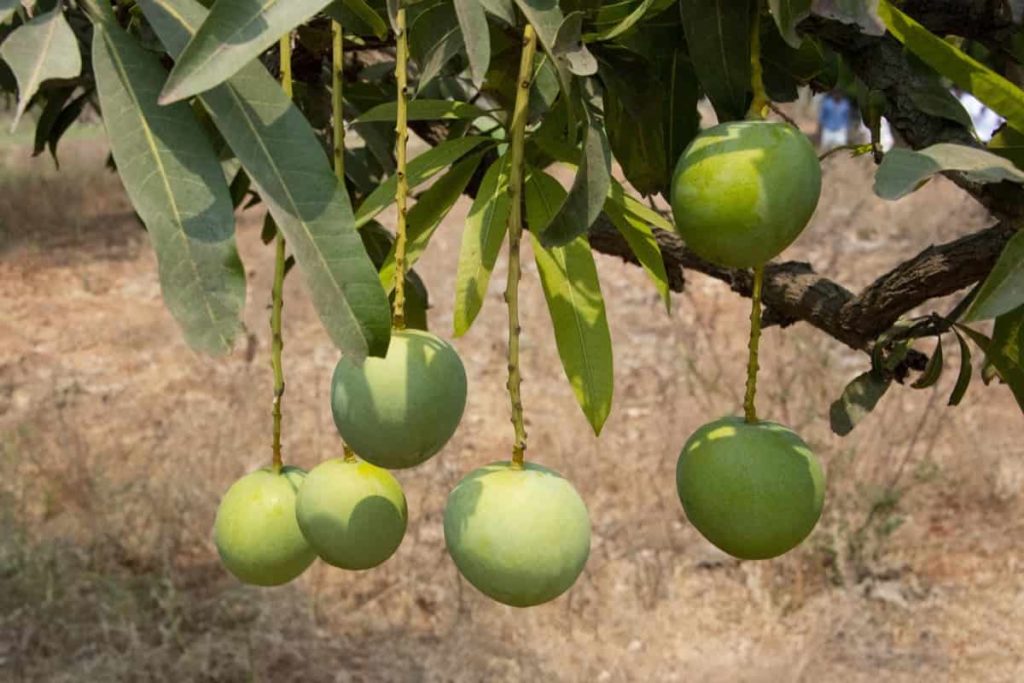Mango is called the king of fruits in India and is also the national fruit due to its wide range of adaptations, high nutritional value, variety richness, delicious taste, and excellent taste. Any treatment that leads to an increase in yield should be supported by good management to keep the tree healthy. Then this includes nutrition, irrigation, pest and disease control, harvesting. Check out the top 14 steps to boost Mango fruit yield below.

Top 14 steps to boost Mango fruit yield
Step 1: Select best soil and climate conditions
Mango tree well adapted to tropical and sub-tropical climate. Mango grows well on a wide range of deep soils (at least 6 feet), well-drained soils, and sandy, rocky, calcareous, alkaline, and waterlogged soils. Mango prefers slightly acidic soils, although it can tolerate a pH range of 5.5 to 7.5.
Step 2: Variety selection for good yield
Choose the type that is best for your zone. The tree can grow in almost any soil, but it needs well-drained soil in a place protected from cold. Plant your tree where it gets full sun for the best fruit production.
Under the Directorate of Agricultural Extension at Kewatkhali in Mymensingh, Bangladesh, the Horticulture Center has developed five high-yielding varieties of Mango (HYVs). The high-yielding varieties are Amropali, Ratna, Sindhu, Mishra Special, and Hybrid-10.
- North India – Best varieties are Dashehari, Langra, Chausa, Bombay Green and Fazri
- South India – Pairi, Suvarnarekha, Mulgoa, Banganapalli, Totapuri, Neelum, Kalapadi and Rumani.
- Western India – Alphonso, Kesar, Mankurad, Fernandin’ and ‘Vanraj’.
- Eastern India – ‘Langra’, ‘Fazri; ‘Chausa’, ‘Zardalu’, ‘Himsagar’ and ‘Malda’
In case you miss this: Best Fertilizer for Mango Tree: When to Apply and How To Apply.

Alphonso Mango for good yield
Farmers cultivate Alphonso Mango in Tamil Nadu to get a good yield and profit. This type of fruit is medium in size, oval in shape, and yellow in color. The quality of the fruit is excellent, and the storage quality is also good. Due to its high demand among consumers, many farmers across the country want to cultivate this delicious fruit in their fields. However, there are only a few states where Alphonso is a natural habitat.
Alphonso’s cultivation is essential for the farmers of Tamil Nadu as the fruit is highly productive and can be very profitable. Therefore, Alphonso cultivation can be very beneficial for farmers. As summer approaches, demand for Mangoes peaks. But many farmers in southern India could not take advantage of Alphonso’s demand. As mentioned above, this type of Mango is generally found in the eastern states of India and not in southern India. This is because the climate of the south of states is not considered suitable for fruit cultivation.
Step 3: Pruning will help to fruit growth
Pruning should maintain a good balance between growth and fruit. The goal of the Mango grower is to cultivate the most marketable fruit at the lowest cost, which can be achieved through selective harvesting. Thinning out the crowded plants and lighting the middle of the tree will permit air for ventilation, sun for coloring the fruit, and ready access for spraying.
In case you miss this: High-Density Mango and Ultra High-Density Plantation Per Acre, Yield In India.

Step 4: Adequate watering
Water the new trees two or three times in the first week, flooding the area around the trunk. Inadequate water supply during fruit development is responsible for fruit drop. Mango trees need watering in the first two years to supplement rainfall and encourage growth.
Step 5: High-density Mango farming
Organic Mangoes are becoming common and valued among consumers in India and abroad. Although moderate, production costs can be reduced with the proper techniques, and profits are significantly higher. For higher yields, farmers cultivate high-density Mangoes where 100 Mango saplings are planted per acre. Although conventional farming techniques with little or no maintenance can yield about 2-3 tons per acre, high-density farming can achieve 9-10 tons per acre.
Step 6: Medium tillage and weeding to prevent soil erosion
Due to the luxuriant branches and roots, the roots of the adult fruit trees are radially spread to the surrounding area. The topsoil should be turned deep to keep the soil loose and breathable during cleaning. Soil should be moved between rows washed with running water to fill, restore the original condition, and prevent erosion and erosion by irrigation or running water, which is not conducive to the growth of fruit trees.
In case you miss this: Organic Mango Farming, Cultivation Practices

Step 7: Planting
Farmers always get vegetatively propagated, true to type plants from recognized nurseries. Popular methods of propagating Mangoes are Veneer grafting, inarching, side grafting, and epicotyl grafting. The primary grafting purpose is to combine the characteristics of a mature fruit tree with the roots of a plant grown from seed. This process helps in cloning breed traits and maintains horticulture in the future, thus making Mango more disease resistant, productive, and commercially viable.
Planting is done at the end of the rainy season in areas with high rainfall. The flowering of Mango trees is an essential physical activity in Mango production as it depends on many factors. Cool temperatures with bright sunshine are a requirement for starting Mango blossoms. Mango trees are alternate carriers and can be from trees or branches inside the trees. Young Mango trees with less than ten years may flower and fruit every year.
Step 8: Adequate plant spacing
The planting distance is 10 meters x 10 meters and 12 meters x 12 meters in dry and humid areas. Therefore, in the model scheme, a spacing of 8 meters x 8 meters per acre is considered with a population of 63 plants which was found to be expected in the covered areas during the field study.
Step 9: Fertilize your tree for plant growth
Fertilize your tree once the new growth has started. Feed it monthly nitrogen plant till autumn. Mango trees should be given an adequate amount of post-fruit manure, flower fertilizer, and fruit fertilizer according to fruit trees’ growth and growth characteristics. Fertilizers should be chosen carefully for good yield. Typically, 170 grams of urea, 110 grams of single superphosphate, and 115 grams of muriatic potash per plant at one to ten years per year.
In case you miss this: Mango Pests, Diseases, and Control Methods – a Full Guide

After that, 1.7 kg, 1.1 kg, and 1.15 kg of these fertilizers per plant can be used every year. Apply in two evenly distributed doses (June-July and October). Foliar spray of 3% urea is recommended before flowering in sandy areas. To encourage the production of flowers and Mangoes, an additional high-speed fertilizer containing nitrogen is applied just before the flowering of the Mango trees.
Is Epsom Salt Good for Mango Trees? If your soil is deficient, give the Mango trees at least one annual dose of magnesium for maximum fruit flavor. Then, add 1 to 3 pounds of Epsom salts per 100 square feet of soil each year. However, if you use dolomite limestone to lower the pH of your soil, this step may be unnecessary.
Step 10: Intercropping
Mango trees can be intercropped to reach a proper height and grow canopy (5-6 years old). Legumes such as Green Gram, Black Gram, Gram, etc., grains like Wheat, Oilseeds like Mustard, Sesame and Peanut, vegetable crops like cabbage, Cabbage, Tomato, Potato, Eggplant, Cucumber, Pumpkin, Bitter Gourd, Tinda, Okra, and Chillies can be grown as intercrops.
Partially shaded crops like Pineapple, Ginger, Turmeric, etc., can be grown in fully grown orchards. In addition to field crops, some short-term, less complete, and dwarf varieties such as Papaya, Guava, Peach, Plum, etc., can be grown unless they interfere with the main Mango crop. It is advisable to take vegetable crops as intercrops for better returns.
Step 11: Control of shoots and promoting flowers
Scientific use of chemicals is required to control the shoots and proper use of chemicals for the growth of flowers. Ring cutting can also promote the differentiation of flower buds and Mango blossoms. One month before flowering bud separation, after cutting the bark on the main stem or main branch 0.5-1.0 cm wide, the stem was peeled off to prevent the photosynthetic product from reaching the root and watering the root to promote flower bud separation and flowering.
Step 12; Pest and disease control
In production and management, we must prevent and control several diseases like anthracnose, powdery mildew, gummosis, and other diseases, and kill armyworm, leafhoppers, and longhorn beetle ensure the average growth of Mangoes. It is also essential to take care of pests and diseases in the care of Mango trees. Deal with them as they do with organic pesticides, cultural and biological controls, or horticultural oils. A wide range of pests, insects, and diseases affect the Mango tree.
Because this fruit tree is susceptible to many diseases, many varieties have been developed that are resistant to disease, dwarf, durable, and highly productive. Most of these pests and diseases can be controlled by pest management and the proper use of fungicides, bactericides, and germicides. Most diseases start at the top of the canopy and spread down to other tree parts. Therefore, it is important to prune the upper foliage and remove diseased leaves and branches.
In case you miss this: Mango Flower and Fruit Drop, Causes, Control Methods.

Two major fungal diseases of Mango trees, namely powdery mildew and anthracnose, are responsible for the failure of Mango trees to bear fruit. These diseases will destroy the panicles, so the Mango tree will not bear fruit. To control fruit drop, spray 20 ppm NAA at pea size of fruits regularly on timely irrigation during fruit development and effectively control pests and diseases.
Step 13: Harvesting stage influences the fruit yield
Mango trees that flowered during October-November will be ready for harvest in April-May. Mango fruits should be harvested while they are green. It takes 120 to 140 days for a ripe Mango fruit to be harvested from the fruit set.
Step 14: New ways to increase Mango production
As a result of scientific farming methods and favorable climatic conditions this season, farmers like Rajesh Shah will get a good yield. Rajesh Shah owns an orchard of Alphanso Mangoes at Fansa village in Valsad district. Pruning and girdling have resulted in optimum flowering in Mango trees. The fruits will be ready to be picked a month in advance and may hit the market by April.
This will give farmers like Rajesh Shah a reasonable price for their produce. At least 100 farmers in the Valsad district are now cutting down their Mango trees and tying the knot in the hope of good yields. Girdling helps process processed food through photosynthesis at the top of the tree. This ensures better flowering and fruiting in the tree. This improves the product a lot.
Rajesh Shah says that the girdling should not be more than one inch deep, even if the width of the tree trunk is 10 inches. Only half of the branches should be girded. This reduces the need for fertilizer by half and ensures maximum fruit on the tree. Girdling needs to be done very carefully. However, if you do not know about Girdling and its effect on a tree in the long run.
- Economical Aquaculture: A Guide to Low-Budget Fish Farming
- 15 Common Planting Errors That Can Doom Your Fruit Trees
- How to Make Houseplants Bushy: Effective Tips and Ideas
- Innovative Strategies for Boosting Coconut Pollination and Yield
- Pollination Strategies for Maximum Pumpkin Yield
- The Complete Guide to Chicken Fattening: Strategies for Maximum Growth
- Natural Solutions for Tulip Problems: 100% Effective Remedies for Leaf and Bulb-Related Issues
- Revolutionizing Citrus Preservation: Towards a Healthier, Greener Future
- Natural Solutions for Peony Leaf and Flower Problems: 100% Effective Remedies
- Maximizing Profits with Avocado Contract Farming in India: A Comprehensive Guide
- Natural Solutions for Hydrangea Problems: 100% Effective Remedies for Leaf and Flowers
- The Ultimate Guide to Choosing the Perfect Foliage Friend: Bringing Life Indoors
- From Sunlight to Sustainability: 15 Ways to Use Solar Technology in Agriculture
- The Ultimate Guide to Dong Tao Chicken: Exploring from History to Raising
- The Eco-Friendly Makeover: How to Convert Your Unused Swimming Pool into a Fish Pond
- Mastering the Art of Delaware Chicken Farming: Essentials for Healthy Backyard Flocks
- 20 Best Homemade Fertilizers for Money Plant: DIY Recipes and Application Methods
- How to Craft a Comprehensive Free-Range Chicken Farming Business Plan
- Brighten Your Flock: Raising Easter Egger Chickens for Beauty and Bounty
- How to Optimize Your Poultry Egg Farm Business Plan with These Strategies
- Subsidy for Spirulina Cultivation: How Indian Government Schemes Encouraging Spirulina Farmers
- Ultimate Guide to Raising Dominique Chickens: Breeding, Feeding, Egg-Production, and Care
- Mastering the Art of Raising Jersey Giant Chickens: Care, Feeding, and More
- Ultimate Guide to Raising Legbar Chickens: Breeding, Farming Practices, Diet, Egg-Production
- How to Raise Welsummer Chickens: A Comprehensive Guide for Beginners
- How to Protect Indoor Plants in Winter: A Comprehensive Guide
- Ultimate Guide to Grow Bag Gardening: Tips, Tricks, and Planting Ideas for Urban Gardeners
- Guide to Lotus Cultivation: How to Propagate, Plant, Grow, Care, Cost, and Profit
- Agriculture Drone Subsidy Scheme: Government Kisan Subsidy, License, and How to Apply Online
- Ultimate Guide to Raising Araucana Chickens: Breed Profile, Farming Economics, Diet, and Care
- Bringing Hydroponics to Classroom: Importance, Benefits of Learning for School Students
- Ultimate Guide to Raising Polish Chickens: Breed Profile, Farming Economics, Diet, and Care
- Ultimate Guide to Raising Australorp Chickens: Profile, Farming Economics, Egg Production, Diet, and Care
- Silkie Chicken Farming: Raising Practices, Varieties, Egg Production, Diet, and Care
- Sussex Chicken Farming: Raising Practices, Varieties, Egg Production, Diet and Care
- Homemade Feed Formulations for Livestock: Discover Cost-effective Starter to Finisher Feed Recipes
This is undoubtedly the best thing that I’ve come across today in the internet. It was a long time that I have been thinking on this topic but I couldn’t satiate my quench for knowledge through any post that I read. However, today that I came across your article, I seem to have learnt a lot and I have also gained enough knowledge on this topic. Thanks once again.
Excellent Article which I was Longing to see for a Long Time. Thanks. Very Informative though I have very Less no of Trees that too in between Areca Plantation but very Educative.
Very good information about mango cultivation.